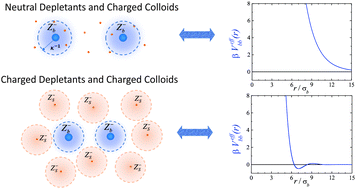Evidence of electrostatic-enhanced depletion attraction in the structural properties and phase behavior of binary charged colloidal suspensions
Abstract
In this paper we study the structure and phase behavior of binary mixtures of charged particles at low ionic strength. Due to the large size asymmetry between both species, light scattering measurements give us access only to the partial static structure factor that corresponds to the big particles. We observe that the addition of small charged colloids produces a decrease of the main peak of the measured static structure factor and a shift to larger scattering vector values. This finding is in agreement with theory based on integral equations with the Hypernetted-Chain Closure (HNC) relation. The effective interaction between two big particles due to the presence of small particles is obtained by a HNC inversion scheme and used in numerical simulations that adequately reproduce the experiments. We find that the presence of small particles induces an electrostatic depletion screening among the big colloids, creating around them an exclusion zone for the small charged colloids greater than that caused in the case of neutral small colloids, which in turn augments the depletion effect.



 Please wait while we load your content...
Please wait while we load your content...